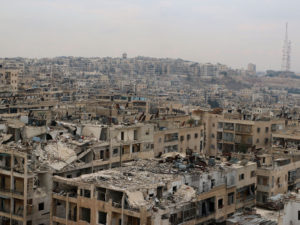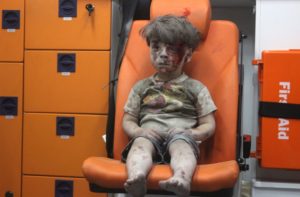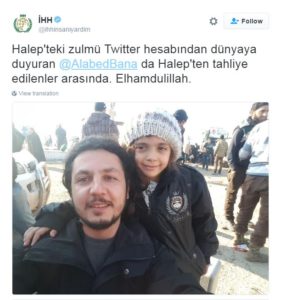Happy Christmas – but let’s hope for a better New Year
As the Christian world pauses for the festive season, much of the planet continues to be mired in conflict, inequality and poverty.
The 65 million people currently displaced around the globe will find little cheer in the holiday season.
The festive spirit won’t be high in the refugee camps of northern Greece and in Turkey, where the UNHCR and other agencies are racing to ‘winterise’ the camps before the snow sets in.
Agencies are distributing blankets, basic relief items and equipment to upgrade shelters to help refugees prepare for the imminent winter. Some camps have been evacuated because of early snowfalls.
 In the Middle East, the battle for Aleppo appears to be entering an endgame with convoys of civilians and the injured finally finding way out of the city despite attacks by militants on some of the convoys and fragile ceasefire.
In the Middle East, the battle for Aleppo appears to be entering an endgame with convoys of civilians and the injured finally finding way out of the city despite attacks by militants on some of the convoys and fragile ceasefire.
A new deal, struck recently, was mediated by Turkey after two previous ceasefires foiled. The new three-stage deal will give civilians, rebels and others loyal to the opposition safe passage from eastern Aleppo, now almost entirely in government control.
The wider conflict in Syria, now five years old and no less bloody or interminable, looks like it has a way to run yet.
In Africa, the Kenyan Government continues to threaten the closure of the world’s largest refugee camp at Dadaab – home to more than 330,000 refugees from Somalia.
Meanwhile, the UNHCR has begun building a new site to reduce overcrowding in the Kakuma refugee camp in northern Kenya, to house refugees fleeing nearby South Sudan.
Already home to nearly 200,000 refugees, Kakuma has seen the arrival of around 44,000 South Sudanese refugees since last year, when fighting broke out between forces loyal to President Salva Kiir and rebels allied with current Vice President Riek Machar.
Kenya hosts the second largest number of refugees on the African continent, some having arrived as long as 25 years ago. Legally, all refugees must live in camps and they cannot work.
With limited funding for protracted displacements, the United Nations has repeatedly cut food rations for refugees in Kenya.
There have been tensions between poor locals living around the camps, who often suffer drought and hunger, and the refugees who receive free food, healthcare and education.
In Europe, almost 5,000 refugees have perished or disappeared in 2016, more than in any other previous recorded year.
An IOM survey of migration on routes across the world found 4,812 were lost in the Mediterranean, in the midst of the greatest migration crisis in Europe since 1945.
And while Europe rushes to steel its external borders against an oncoming wave of migration, its internal political union is dissolving under a storm of populist nationalism.
2016 has seen Brexit and the French Government’s ongoing scorched-earth demolition of the camp in Calais known as “the Jungle”.
Germany and Sweden have started deporting people they regards as “failed asylum seekers”.
And in the east, Hungary’s recent botched referendum further underscores the xenophobic panic driving right-wing forces across Europe’s eastern and southern frontiers.
But it is not clear that Europe’s new harder-line stance is deterring new arrivals. The humanitarian think tank the Overseas Development Institute (ODI) says asylum seekers are merely opting for more covert and dangerous routes.
The ODI says that while official sea arrivals dropped to about 358,000 so far this year, compared to just over one million in 2015, there were 950,000 new asylum seeker claims in EU member states, between January and September.
European Union ministers remain gridlocked over plans to distribute about 120,000 asylum seekers among member states by controversially allotting migrants according to countries’ economic and social capacity.
Without a relocation plan, Brussels has resorted to dumping refugees over the border in Turkey, where an increasingly authoritarian government is getting paid billions to warehouse desperate refugees.
 In the Americas, Donald Trump’s election as the 45th president of the United States or America presents some serious challenges and enduing uncertainties for the humanitarian sector in general, and refugees in particular.
In the Americas, Donald Trump’s election as the 45th president of the United States or America presents some serious challenges and enduing uncertainties for the humanitarian sector in general, and refugees in particular.
Trump has said he will build a wall on the border with Mexico while the US has accepted tens of thousands of largely child-age asylum seekers from Central America – most fleeing violence and gang related strife in El Salvador, Guatemala and Honduras.
If America physically closes its border with Mexico, countries such as Costa Rica and Mexico will be forced to accommodate more of these refugees despite a dire lack of capacity to do so.
Trump said he will prevent Muslims from entering America. Under the Obama administration, the US agreed to accepted 10,000 refugees a year from Syria – victims of a conflict which has driven much of the current global refugee crisis; the worst in history.
Among all of this bad-to-disastrous news, there are a few glimmers of hope.
This year’s UN Refugee Summit saw the New York Declaration for Refugees and Migrants expresses the political will of world leaders to save lives, protect rights and share responsibility on a global scale.
It claimed for itself bold commitments both to address the issues the world now faces and to prepare the world for future challenges.
These include commitments to: protect the human rights of all refugees and migrants, regardless of status. This includes the rights of women and girls and promoting their full, equal and meaningful participation in finding solutions; to ensure that all refugee and migrant children are receiving education within a few months of arrival; prevent and respond to sexual and gender-based violence; and support those countries rescuing, receiving and hosting large numbers of refugees and migrants.
It also commits to: work towards ending the practice of detaining children for the purposes of determining their migration status; strongly condemn xenophobia against refugees and migrants and support a global campaign to counter it; strengthen the positive contributions made by migrants to economic and social development in their host countries; and, improve the delivery of humanitarian and development assistance to those countries most affected.
 But perhaps the most compelling reasons for hope come from some of the youngest victims of the global refugee crisis.
But perhaps the most compelling reasons for hope come from some of the youngest victims of the global refugee crisis.
The iconic image of Syrian boy Omran Daqneesh sitting on a chair inside an ambulance covered in blood and dust following an airstrike is emblematic of the resilience and fortitude of refugees across the globe.
And seven-year-old Bana al-Abed, whose tweets provided a glimpse into the violence and terror of besieged Aleppo, became the subject of world-wide concern when her twitter feed suddenly ceased.
 Fears for Bana al-Abed’s safety spiked when her account, run by her mother, Fatemah, was shut down and speculation mounted that the family had been in fighting or captured by Government forces.
Fears for Bana al-Abed’s safety spiked when her account, run by her mother, Fatemah, was shut down and speculation mounted that the family had been in fighting or captured by Government forces.
The last message from east Aleppo, signed on Sunday night by her mother, was a plea to bring the family to safety: “Please please please make this ceasefire work & get us out now. We are so tired”.
Hours later, as a stalled evacuation resumed, a Turkish NGO revealed Bana had made it safely out.
To all our readers: best wishes for the festive season from the team at iMPACT.












